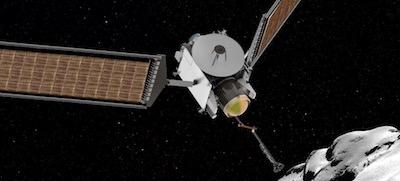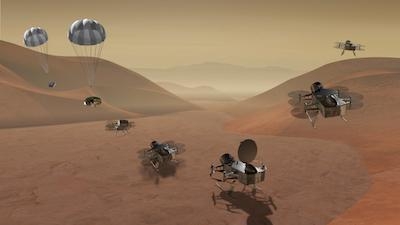Two Finalists Concepts Chosen For Robotic Deep Space Exploration
NASA has selected two finalist concepts for a robotic mission planned to launch in the mid-2020s: a comet sample return mission and a drone-like rotorcraft that would explore potential landing sites on Saturn’s largest moon, Titan.

The agency announced the concepts last week, following an extensive and competitive peer review process. The concepts were chosen from 12 proposals submitted in April under a New Frontiers program announcement of opportunity.
“This is a giant leap forward in developing our next bold mission of science discovery,” said Thomas Zurbuchen, associate administrator for NASA’s Science Mission Directorate in Washington. “These are tantalizing investigations that seek to answer some of the biggest questions in our solar system today.”
The finalists are:
Comet Astrobiology Exploration Sample Return (CAESAR)
The CAESAR mission seeks to return a sample from 67P/Churyumov-Gerasimenko, a comet that was successfully explored by the European Space Agency’s Rosetta spacecraft, to determine its origin and history. Led by Steve Squyres of Cornell University in Ithaca, New York, CAESAR would be managed by NASA’s Goddard Space Flight Center in Greenbelt, Maryland.
Dragonfly

Dragonfly is a drone-like rotorcraft that would explore the prebiotic chemistry and habitability of dozens of sites on Saturn’s moon Titan, an ocean world in our solar system. Elizabeth Turtle from the Johns Hopkins University Applied Physics Laboratory (APL) in Laurel, Maryland, is the lead investigator, with APL providing project management.
The CAESAR and Dragonfly missions will receive funding through the end of 2018 to further develop and mature their concepts. NASA plans to select one of these investigations in the spring of 2019 to continue on to subsequent mission phases.
The selected mission will be the fourth in NASA’s New Frontiers portfolio, a series of principal investigator-led planetary science investigations that fall under a development cost cap of approximately $850 million. Its predecessors are the New Horizons mission to Pluto and a Kuiper Belt object known as 2014 MU69, the Juno mission to Jupiter, and OSIRIS-REx, which will rendezvous with and return a sample of the asteroid Bennu.
NASA also announced the selection of two mission concepts that will receive technology development funds to prepare them for future mission competitions.
The concepts selected for technology development are:
Enceladus Life Signatures and Habitability (ELSAH)
The ELSAH mission concept will receive funds to develop cost-effective techniques that limit spacecraft contamination and thereby enable life detection measurements on cost-capped missions. The principal investigator is Chris McKay of NASA’s Ames Research Center in California’s Silicon Valley, and the managing NASA center is Goddard.
Venus In situ Composition Investigations (VICI)
Led by Lori Glaze at Goddard, the VICI mission concept will further develop the Venus Element and Mineralogy Camera to operate under the harsh conditions on Venus. The instrument uses lasers on a lander to measure the mineralogy and elemental composition of rocks on the surface of Venus.
The call for concepts was limited to six mission themes: comet surface sample return, lunar south pole-Aitken Basin sample return, ocean worlds (Titan and/or Enceladus), Saturn probe, Trojan asteroid tour and rendezvous, and Venus in situ explorer.
(Images provided with NASA news release)
 ANN's Daily Aero-Term (04.28.24): Airport Marking Aids
ANN's Daily Aero-Term (04.28.24): Airport Marking Aids Aero-News: Quote of the Day (04.28.24)
Aero-News: Quote of the Day (04.28.24) ANN's Daily Aero-Linx (04.28.24)
ANN's Daily Aero-Linx (04.28.24) Aero-News: Quote of the Day (04.29.24)
Aero-News: Quote of the Day (04.29.24) ANN's Daily Aero-Linx (04.29.24)
ANN's Daily Aero-Linx (04.29.24)




